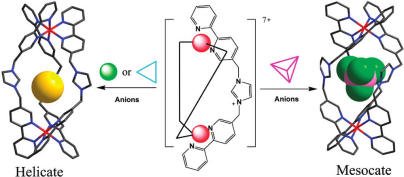Helix is an important structural motif in nature. Dinuclear triple-stranded [M2L3] complexes, as simple models for more complex natural structures of biological molecules, have been of much interest.
Researchers from Lanzhou Institute of Chemical Physics (LICP) of the Chinese Academy of Sciences (CAS), and University of Glasgow, have successfully synthesized a series of highly charged, dinuclear triple-stranded cagelike [M2L3]7+ complexes by employing an imidazolium-bridged bis(2,2′-bipyridine) ligand (L) and a FeII or CuII ion.
 |
The work has received support from the National Natural Science Foundation of China. The findings have been published in Inorg. Chem. (Inorg. Chem. 2012, 51, 179?187).


